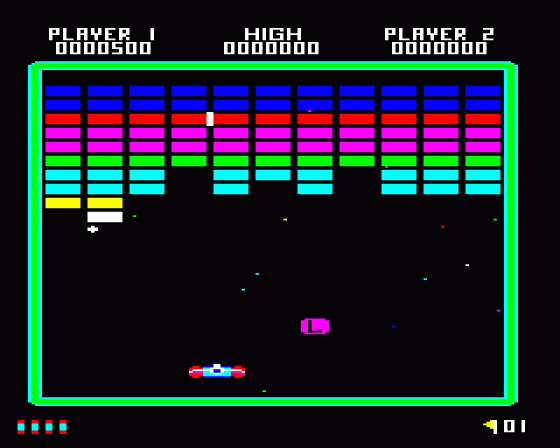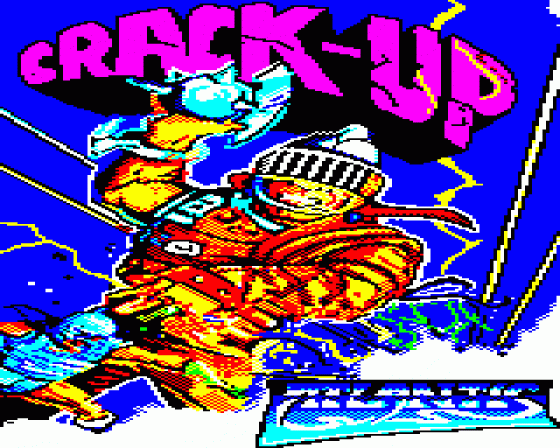Most machines have an ample supply of clones of the Arkanoid-style "bat and ball" game. The object is simply to hit coloured blocks with a ball, whilst keeping the ball in the playing area, with a bat at the bottom of the screen. If you miss the ball, then you lose a life. If you destroy all of the blocks, then you move on a level. All you need do is survive for as many levels as possible.
The BBC, it has to be said, got a rather superb official conversion of "the daddy" Arkanoid in the early Eighties, but the clones came somewhat later for the Acorn Electron. It may not be co-incidence that both Hyperball (by Superior) and Crack-Up (by Atlantis) arrived almost ten years later to fill that 'gap' in the market. Hyperball went for a glammed up approach to the old favourite with multi-load levels and a shop from which you could buy awesome new block-busting weapons. Crack-Up, on the other hand, has simply taken all the elements of the traditional game and created it on the Elk from scratch.
A budget game without pretensions, Crack-Up gears up with a loader not dissimilar to that of the old Acornsoft titles and, in fact, the game itself follows all of the Acornsoft traditions. It has an introductory page with a title, the option to use both the First Byte and Plus 1 joysticks and a one or two player option - all done in monochrome. There is also a Starting Level facility, allowing you to start at any level from 1 to 5.

The game itself is, in a word, superb. The action is set on scrolling multi-coloured parralax stars and preceded by 'Get Ready Player 1' in huge text scrawled across the playing area. The game is rendered in Mode 2, meaning that all seven of the Electron's colours are on display and if you think this means that the speed of the game will suffer then you are mistaken. As expected, there are ingenious combinations of different types of block towards the top of the playing area and you control a elongated rectangle done in cyan (with red, rounded ends) at its bottom.
You aim, launch the ball with RETURN and need to gauge accurately its angle on its return so that it strikes the bat to ricochet in the appropriate direction. Each time you hit a block you get 10 points, and the possibility that a bonus pod will drop towards the bat. Catch one and the bat will mutate in some way, usually to your advantage. The pods are marked with letters - giving you have a few seconds to decide if you wish to 'trade' the current state of your bat for what is marked on the pod. What you are happiest with usually reflects your own playing style, although the L(aser) pod is usually worth more risk than the others, as this allows you to fire bullets into the playing area.
On the first level, the ball's contact with each one of the multi-coloured blocks results in the block disappearing, but as the levels progress, the block may change colour on the first, second or third hits and only finally disappear on the fourth. In addition, some, but not all, of the blue blocks are completely indestructible and exist merely to hinder the balls progress to others. Any impact, either with a block, the bat or the outside border of the playing area causes a blippy sound effect, whilst picking up bonuses, especially the B pod (which immediately takes you to the next level) emits the kind of fanfare that would do an Eighties Arcadians machine proud. Invisible blocks also begin to pervade the playing areas from level 6 onwards.

There are several types of pod upgrades, apart from the level jump and laser mentioned. C is Catch Ball, upon which the ball will not ricochet from your bat but instead sit on it until you press RETURN to release it. This allows you time to reposition the bat as appropriate. D is Double Balls, will divides the ball, wherever it may be on screen, into two. You then need to try and keep both in the playing area for as long as possible, although you will not lose a life as long as one remains there. E extends the bat by half its size, meaning positioning it is easier, and S slows down the ball for about half a minute. After this time though, beware, because it speeds up quickly to the same speed as it was before you collected the pod.
The graphics, whilst simple, are excellent, and the whole of the screen is laid out perfectly. Across the top are scores for Player 1, the High Score, and Player 2. Across the bottom are the lives (in small bats) left to the currently-playing player, and the level he has reached, shown by a little flag reminiscent of Arcadians. The 32 levels of the game, as they increase, also become much more puzzling, making the game not only aesthetically attractive but also extremely addictive. It is also neither too difficult nor based entirely on luck. Unlike in some clones, the next level (B) pods do tend to drop just as often as the other pods, meaning in an average game, you do not have to clear every level of every block.
Superb as this game is though, one little niggle concerns the laws of contact between bat and ball. Whilst I am by no means an expert on such things, on other clones I have noticed that where the ball strikes the bat should determine to some extent the angle at which it ricochets. So a ball travelling in from the right, if it strikes the right side of the bat, should rebound to the right. Whilst for the most part, Crack-Up did seem to follow these 'rules', on some occasions it seemed it randomly broke them, and the angle at which the ball rebounded was quite bizarre. I would also liked to have seen a pod for 'Destructo-Ball' (present in Arkanoid) which, for a short time, allows to ball to wipe out anything, even the 'indestructible' bricks, in its way.
As stated above, the game was written by Spike Moiran (who seems only to have written this and Cops 'N Robbers) and released late in the Electron's shelf life. I have no hesitation in noting though, that had it been around at the beginning, it would no doubt be regarded with the same nostalgic appreciation as any of the Acornsoft videogame clones (Hopper, Meteors, Monsters, Planetoid, etc). Even comparing it with the PC clones available today, I find it hard to fault. It is one of the best games I have ever seen, and to think it retailed at just £1.99 on cassette is scarely believable.
In closing then, a tip for when you've gotten hold of that laser pod. Position your laser-bat carefully, as the programmer has cunningly allowed for the bullet to travel between the blocks if you do not!
Other Reviews Of Crack-Up For The BBC/Electron
Crack Up (Atlantis)
A review by Dave Reeder (A&B Computing)
Crack-Up (Atlantis)
A review by Dave E (Everygamegoing)


 1st January 2006
1st January 2006












